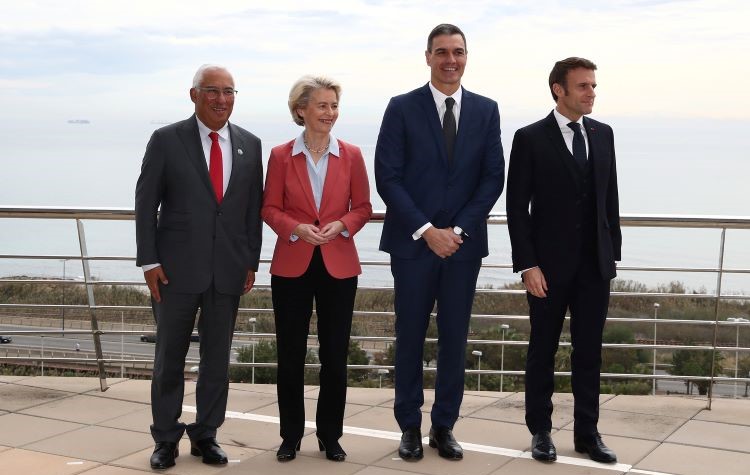The Diplomat
The Governments of Spain, Portugal and France presented yesterday the H2Med energy interconnection project, the first great green corridor that will connect the Iberian Peninsula with Marseille and, through this French city, with the rest of Europe and that will be operational in 2030.
The President of the Government, Pedro Sánchez; the President of the French Republic, Emmanuel Macron; the Prime Minister of the Portuguese Republic, António Costa, and the President of the European Commission, Ursula von der Leyen, met yesterday at the headquarters of the EU Intellectual Property Office (EUIPO) in Alicante to unveil the details of the H2Med project, the first major hydrogen corridor in the EU. The meeting coincided with the celebration in Alicante of the ninth Summit of the countries of the South of the EU (MED-9).
According to Sánchez, the launching of H2Med responds to the commitment made last October 20 by the leaders of the three countries in Brussels, when they agreed to work together to implement a green energy corridor capable of linking the peninsula with the French city of Marseille.
The project, according to the President of the Government, has two fundamental parts: “On the one hand, the route from Portugal to Spain, specifically from Celorico da Beira to Zamora; and, on the other hand, the route from Spain to France through the Mediterranean, from Barcelona to Marseilles”. In addition, he continued, the corridor will make it possible to strengthen the EU’s energy security and energy autonomy in a context in which “it is essential for Europeans to show solidarity in order to reduce energy dependence”.
According to the preliminary technical specifications of the H2Med project, the section between Celorico (Portugal) and Zamora will extend over 248 kilometers. The estimated cost is 350 million euros. As for the Barcelona-Marseille (France) section, the estimated cost is 2.5 billion euros for a 455-kilometer connection. As stressed by the President of the Government, the infrastructure as a whole will be operational by 2030.
According to Sánchez, the new infrastructure could be operational by the end of this decade and “will be capable of transporting 10% of the EU’s hydrogen consumption by 2030”, equivalent to two million tons per year. The presentation of H2Med as a Project of Common Interest (PCI) will take place before December 15, which will allow the corridor to qualify for European funding instruments, such as the Connecting Europe Facility.
H2Med is part of the REPowerEU Plan, adopted last May 18 by the European Commission to respond to the challenges and disruptions in the global energy market caused by the war of Russian President Vladimir Putin in Ukraine. This plan, designed to make Europe independent of Russian fossil fuels by 2030, already included energy savings, clean energy production and diversification of our supplies among its primary objectives.
During the statement to the media, Von der Leyen said that “the H2Med project is going in the right direction” because “it has the potential to help us build a European backbone for transporting hydrogen” and will contribute to making the Iberian Peninsula “one of the main energy hubs of the European Union”. For his part, Emmanuel Macron affirmed that HSMed responds to three objectives, ecological, industrialization and energy autonomy, while Costa insisted on the need to continue diversifying the market to gain energy independence.
MED-9
On the other hand, the Heads of State and Government of Croatia, Cyprus, France, Greece, Malta, Portugal, Slovenia and Spain, and the Deputy Prime Minister of Italy, concluded yesterday in Alicante the ninth Summit of the countries of the South of the EU (MED-9) with the signing of a joint declaration in which, “in a context marked by the Russian war of aggression against Ukraine and at a time when we have not yet overcome the impact of the COVID-19 pandemic”, reiterated their “determination to continue to provide strong support for Ukraine’s overall economic, military, social and financial resilience, including humanitarian assistance”.
Likewise, the Southern EU countries assumed “a special responsibility for the promotion of the EU Southern Neighborhood” and committed themselves to “further develop its architecture, as well as to promote the implementation of the New Agenda for the Mediterranean and its adaptation to the new geopolitical circumstances.”
The MED-9 also called on the “Maghreb partners to resume the path towards greater regional cooperation and integration”, because “this would allow them to face together the multiple social, economic and environmental challenges, as well as to seize opportunities, including those offered by the European Neighborhood Policy”. We therefore “encourage our partners to reduce current tensions and to continue to work together with us to create the conditions for shared stability and prosperity for all the peoples of our region.”
Speaking to the press afterwards, the Prime Minister reiterated the importance of keeping an eye on the strategic importance of relations with the Southern Neighborhood. “Right now the European Union is focused on the Eastern flank, and therefore we must pay attention to our closest neighbors in the South, with whom we share interests and challenges,” he declared. The stability of the Southern Neighborhood, he added, is “fundamental for the stability of Europe”. For this reason, Sánchez reiterated the willingness of the MED-9 countries to develop a “new common agenda for the Mediterranean”, an agenda “in which the European Union shows its commitment to the South, as an area whose relevance must be taken into account”.
Ursula von der Leyen, and the President of the European Council, Charles Michel, attended the first working session of the MED-9, where their leaders underlined the importance of maintaining European unity and solidarity in the face of Putin’s blackmail by exploiting gas and oil. During this working session, the MED-9 leaders focused their discussion around the Market Correction Mechanism, the Commission’s proposal on a gas price cap. “This proposal needs adjustments and we have agreed to work together in that direction,” Sanchez told the press.






